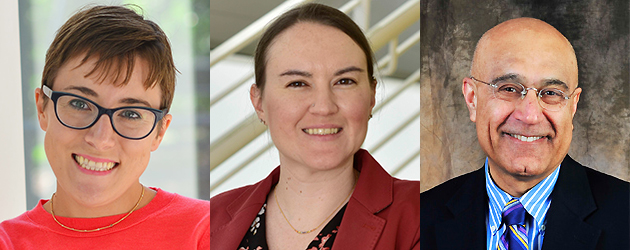 |

|
 |
From left: Dr. Shelby Bensi, assistant professor, civil and environmental engineering; Dr. Katrina Groth, associate professor, mechanical engineering; Dr. Mohammad Modarres, Nicole Y. Kim Eminent Professor and director of the Center for Risk and Reliability. |
|
Being able to assess and manage risks effectively is of obvious importance to the nuclear industry, which pioneered many of the tools used in risk assessment today.
Though they’ve served the industry well, contributing to a positive safety record, those tools are becoming out of date, says University of Maryland (UMD) assistant professor of civil and environmental engineering Shelby Bensi. With support from the Nuclear Regulatory Commission (NRC), Bensi and Nicole Y. Kim Eminent Professor Mohammad Modarres—a member of the UMD mechanical engineering department and head of its nuclear engineering program—are collaborating on research to explore potential ways to update available tools.
“The industry has been investing in the same tools for decades, and these tools are built on decades-old technology. As we try to create better models to understand more sophisticated types of scenarios, we’re pushing the limits of what these tools can do,” Bensi said. “Up until now, we’ve found workarounds for the limitations of the older tools, but the result is that we’ve created a challenging technical situation. We calculate the risks correctly, but in a way that is not very transparent and is difficult to maintain. On the other hand, we can’t just throw out the existing tools. They encode an immense amount of knowledge.”
“Ideally, we want to continue to leverage the information that’s inside of those older risk tools, while also leveraging newer technologies. We want to create hybrid structures that allow us to benefit from what we had before, even as we innovate,” she said.
The collaboration pairs Bensi’s expertise in risk assessment tools—such as Bayesian networks—with Modarres’ unparalleled knowledge of the engineering involved in building, operating, and maintaining a nuclear plant.
It’s also a timely endeavor: with climate change producing a greater number of severe weather events, including floods, the nuclear industry is having to factor in the increase in external hazards.
“There’s a heightened concern about floods,” said Modarres, who directs the Center for Risk Reliability (CRR), a think tank based at the A. James Clark School of Engineering that brings together experts from across the UMD campus, including Bensi. “Nuclear plants typically need to be located next to large bodies of water, for cooling purposes. If you build them in the middle of a desert, they’re not going to be very efficient. But proximity to water means the risk of flooding, and climate change is exacerbating that risk.”
The project is one of three in which Bensi is collaborating with colleagues in the mechanical engineering department. In one, supported by an approximately $800,000 grant from the Department of Energy, Bensi is partnering with Katrina Groth, associate professor of mechanical engineering and associate director of CRR, to study the use of Probabilistic Risk Assessments (PRA) in planning for external hazards such as flooding at nuclear power plants. Bensi’s focus in this study is primarily on the external hazard PRAs, while Groth is investigating the human factors that can come into play during an external hazard event. Besides Bensi and Groth, the team involved in this project includes Zeyun Wu (Virginia Commonwealth University), Zhegang Ma (Idaho National Laboratory), Hongbin Zhang (Idaho National Laboratory), and Ray Schneider (Westinghouse Electric Company).
Meanwhile, Bensi and Groth received a $450,000 NRC Faculty Development Grant aimed at spurring collaboration between civil and mechanical engineers on topics related to nuclear risk assessment.
It’s an area of study that naturally lends itself to cross-departmental work, Bensi said.
“Nuclear power plants are comprised of systems that are mechanical, such as pumps, generators, and valves, as well as other elements that come under civil engineering, such as containment structures, flood protection, and earthquake load resisting systems,” she said. “Understanding reliability and risk as it pertains to these systems requires expertise not only in mechanical systems reliability, but also in structural reliability and the study of natural hazards, both of which are typically within the domain of civil engineers.”
“Another issue is human reliability, related to how humans perform as part of a complex engineering system in various situations, and that is something that my colleague Groth, and other UMD mechanical engineers, have focused on,” Bensi said. "In fact, Dr. Groth is currently leading an NRC-sponsored project focused on ways to strengthen the technical basis of human reliability analysis tools used in nuclear PRA."
While topics such external hazards, equipment reliability, and human performance seem relatively diverse, Bensi and Groth use the common mathematical language of Bayesian networks as a way to understand the risks in these complex systems. “There really are a lot of avenues for collaboration," Bensi said.
October 27, 2021
|

